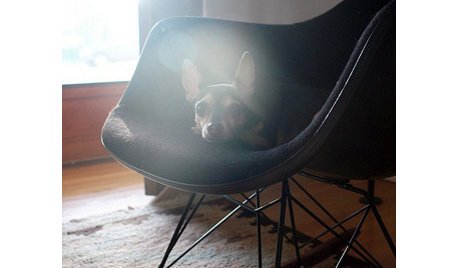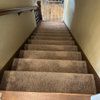Dog aggressive when people are leaving
My friend adopted a lab/doberman mix from a shelter a year ago. Her dog (Violet) had been at the shelter for almost a year; she was surrended initially after her owners were arrested, and then was adopted, but returned, because she was aggressive towards another dog in the home.
Violet is friendly and well-behaved with me and my dog. And no problems with kids. But, my friend says that Violet seems less friendly towards certain adults who come over (mostly men, but not always). And has, on occasion, lunged at people as they are leaving. My friend is a fan of Cesar Milan, and watches his show regularly, but hasn't seen this issue addressed. Of course, for now she puts her dog in a down/stay as people are leaving, and keeps a close eye on her, but would really like to understand her dog's fear? motivation? Why would her dog stay calm for a long period of time when someone is in the house, but show aggression as they leave?
Comments (31)
cindyb_va
14 years agolast modified: 9 years agoDang, hit return too soon, apologies...
Lunging is definitely level 10. The correction your friend makes should be well before the lunging. Dogs always give off body language that shows they are preparing to attack. They get a decided "look" in their eyes.
Also, it is important for your friend to realize that it is much easier to train a dog out of dominance aggression than fear aggression. Encourage her to be patient but firm. Our current dog is fear aggressive; with him it is a lifelong work in progress, but we have seen marked improvements in his behavior after adopting some of Cesar's strategies and working with a professional dog trainer.
Good luck to your friend!
Related Professionals
Washington Architects & Building Designers · Town and Country Architects & Building Designers · Belle Glade Interior Designers & Decorators · Bridgeport Furniture & Accessories · Portland Furniture & Accessories · Roseville Furniture & Accessories · Hilton Head Island Furniture & Accessories · Graham Cabinets & Cabinetry · Middletown Cabinets & Cabinetry · Bella Vista Flooring Contractors · Hialeah Gardens Flooring Contractors · Kent Flooring Contractors · Panama City Beach Flooring Contractors · Powell Flooring Contractors · Skokie Flooring Contractorsmazer415
14 years agolast modified: 9 years agoYou have some good responses here, but lets see if we can get to the root of the problem. How much leash walking and basic training does this dog have? How much stimulation does the dog get? Does this behavior only occur inside the home when people are leaving or does it happen outside as well? Are there other behavioral issues? I suspect the dog does not get out much due to the fear surrounding its agression towards other dogs.
Without knowing much more I would suggest the owner purchase a muzzle (not the cloth kind - but a real muzzle) next I would start the dog on a schedule which includes 30 minute leash walking (brisk) at least 3 times a day, basic positive reinforment training, and nothing in life is free program, in other words the dog MUST work for every food morsel it gets. This way the dog will start to see its owners as the dominants of the house. Dobermans were bred SPECIFICALLY to assist tax collectors not only for protect but as extra muscle as well. I look forward to learning more about this dog.User
14 years agolast modified: 9 years agoShort term fix would be to leash the dog before people leave. The owner calls the dog to them, attaches the leash, and the visitors/owner begin the departure process. The owner needs to be alert to the first sign of aggression and make a short side jerk on the leash---just enough to get the dogs attention duverted from the unwanted bahavior. Do not jerk backwards, as that causes tension restraint---which increases aggression.
The rest of the advice---training/exercise---is good. Trying the above should fix the immediate problem so the long term training can fully correct bad behavior.
freezetag
Original Author14 years agolast modified: 9 years agoCindy, you are right - "calm" was probably not the right word to use. I haven't seen this myself, but because my friend says that she can tell when Violet doesn't like someone, I agree that she is probably not calm at all, just not actively behaving badly. And my friend knew that Violet might have some issues, given her background, but adopted her because she also has many good qualities (generally well-behaved, loving, likes kids, etc). She knows that this issue won't be solved overnight - but would be happy to know that you have had some improvement with fear-based aggression.
I will ask my friend whether she has seen anything leading up to the lunging. She did not mention growling, but maybe there is some other low-level behavior she can correct. I'm guessing the lunging took her by surprise - normally you would be paying attention to your guests as they are leaving, so she may have missed some signs.
Mazer, Violet goes for a daily walk, and knows basic commands. There are two boys in the family (10 & 12), and they have a large yard to play in. I bring my dog over a few times per week so that she and Violet can play (because my dog is younger and an hour of racing around with another dog improves her behavior immensely). So Violet is alone much of the day, but has quite a bit of stimulation during the afternoon/evening hours.
I wish that Violet could come over to our house, but our yard isn't fenced, and my friend is not comfortable letting her run without a fence. Sometimes we walk them together, and I can see that Violet really enjoys leash walking - she is very focused on the walk itself and gets irritated if my dog tries to engage her in playing (which I appreciate, since I agree that the dogs should not be racing around when we are trying to walk them).
Not sure about the dog agression issues - I know that the people at the animal shelter said that Violet's behavior with other dogs had improved while she was at the shelter. When we walk, and encounter other dogs, I haven't seen anything unusual, but there is not much interaction - generally they just pass each other. She does approach other dogs in a different way than mine does, though. My dog (to me) looks very deferential (low to the ground, and approaches slowly), while Violet maintains her usual stance. I don't see her bristle - what else do you look for? My friend has said that Violet does act agressive (barking, growling) with some dogs (generally when the other dogs are in a fenced yard).
cindyb_va
14 years agolast modified: 9 years agowhat else do you look for?
Tail stance (up/level/down/tucked) and ear carriage (alert/relaxed) are two big "tells" for most dogs. My own dog gets a look in his eye first, it is hard to describe, but its a sort of narrowing of the eyes and a glaring stare.
What helped us recognize these things was working with a trainer. I had the trainer come to our house for a visit and he helped us learn to recognize the dog's body language. We had never dealt with a fear aggressive dog before and knew we needed some professional help. It was worth every $.
Have your friend consider hiring a trainer that specializes in fearful dogs. I suspect the shelter people would know of someone.
todancewithwolves
14 years agolast modified: 9 years agoMy Cocker use to do that. He'd only attacked when people left. It's separation anxiety. He would even attack me.
leeza09
14 years agolast modified: 9 years agoI too facing the same problem with my Doberman. she will be very calm when person enter the house but will start to shout when they go out. might be she does not like people going out with out playing with her. but has not attacked anyone.
freezetag
Original Author14 years agolast modified: 9 years agoThanks for all the responses! Will talk this over with my friend and post again (we tend to talk about our dogs a lot, and bounce ideas off each other, but I have not been any help so far with this).
I don't think Violet has separation anxiety issues - she is alone for several hours most days, and doesn't fuss when left alone. And she is fine with most people leaving - there are just a certain few people who trigger this misbehavior.
She seems especially fond of me and my family - I think because she associates us with the time she spends with my dog. Wonder if it would help to have the people she fears/misbehaves with bring my dog in the house?? The dogs definitely are not concerned with us humans once they have each other.
mazer415
14 years agolast modified: 9 years agoHere is the deal. The dog in question has aggression issues.
You wrote: "I haven't seen this myself, but because my friend says that she can tell when Violet doesn't like someone" it is quite possible your friend is seeing a reaction in the dog and she herself is tensing up, which will in turn cause the dog to ramp up its negative response to whoever it is reacting to.You wrote: just not actively behaving badly. Lunging at people OR ANY aggression towards anything or anyone should not be tolerated and it is behaving badly
You wrote: I will ask my friend whether she has seen anything leading up to the lunging. She did not mention growling, but maybe there is some other low-level behavior she can correct. I'm guessing the lunging took her by surprise - normally you would be paying attention to your guests as they are leaving, so she may have missed some signs. Some dogs give ABSOLUTELY NO SIGN BEFORE AN ATTACK.
You wrote: Mazer, Violet goes for a daily walk, and knows basic commands. There are two boys in the family (10 & 12), and they have a large yard to play in. I bring my dog over a few times per week so that she and Violet can play (because my dog is younger and an hour of racing around with another dog improves her behavior immensely). So Violet is alone much of the day, but has quite a bit of stimulation during the afternoon/evening hours.
This right here is the key. The dog is spending too much time without stimulation and too much time in the same area - I call this the fish bowl syndrome. I bet the walks are leisurely and involve alot of sniffing around. This dogs walk should be at least 30 minutes a walk and should be a brisk walk at least 3 times a day, more on the weekends. You wrote when the dog has exercise period where it can run full out with another dog in play time, it demonstrates better behavior...this tells me right off that the dog needs more play time OUTSIDE of its yard, and more discipline. Even tho play time with dogs is very important and helps with socialization, the people in this dogs life should be having more interactive and controlling role.
You wrote: I can see that Violet really enjoys leash walking - she is very focused on the walk itself and gets irritated if my dog tries to engage her in playing ***This behvaior SHOULD NOT be tolerated from Violet.
You wrote: Not sure about the dog agression issues - My friend has said that Violet does act agressive (barking, growling) with some dogs (generally when the other dogs are in a fenced yard). THIS IS DOG AGGRESSION.What I see is that this dog has had aggression issues in the past that the previous owner either ignored or did not want to deal with. The dog is now displaying aggression tendencies again. Which tells me it is feeling comfortable in its new home and it is ready to take the dominant role in the environment. No act of aggression whoever small should be tolerated. I can predict that if the aggression ssues are not taken care of immediately and without limits that this dog will bite. Whether it be another dog or a human, it will escallate without immediate and consistant correction.
Another dog to play with is great, but it is not going to solve the problem. I suggest more training, brisk walks more than in the morning and at night and faster than at a leisurely walk. You mentioned the family has two boys and it would be great once the dog can be trusted more that the boys take the dog with them skateboarding, roller blading or bike riding. Let the dog pull them. *This can take a bit of patience and perseverance.
This dog needs help, the faster it gets what it needs the better.freezetag
Original Author14 years agolast modified: 9 years agoYes, Mazer, I think we've established that she has an aggression issue! (hence this post)
Of course when a dog lunges at someone, it is behaving badly. No one disputes that, or has suggested that it should be tolerated. When I said that Violet was not "actively behaving badly", I was referring to the period of time where a disliked visitor is in the house, and Violet is lying down quietly. I had at first described her as "calm", but as Cindy pointed out, she is probably not feeling calm - she is probably tense. But not doing anything at that point.
I agree that most dogs would benefit from more exercise (as would most people!) But I didn't say that Violet's behavior improves after a good play session - I was referring to my dog (who just turned 1). Violet is a little older (3 years) and while I'm sure that exercise is good for her, I don't know that it would help her agression, if it is fear-based (which I suspect it is). My dog, however, does behave better after she's exercised (keeps her from jumping up, being overexcited, and chewing things up). Sorry if that was confusing.
When two dogs are walking on a leash, and one dog (my dog) jumps on or chases the other dog (Violet), I think Violet is within her rights to growl at my dog. I think I am the one at fault when that happens - I know my dog is playful and should be more careful to keep her under control. Violet has never hurt my dog - to me it just looks the same as when a mom dog teaches a pup manners.
Yes, barking and growling at other dogs is aggression. I just said I wasn't sure about her aggression issues with other dogs because I haven't personally witnessed it, and don't know how much of a problem it is.
The previous owner was arrested for selling crack, so I'm guessing you are right that any dog issues were not a top priority. It sounds almost as if you think that her aggression is now tolerated, but really, it is not. I don't think that Violet has become more or less agressive in the past year - she only acts out around a few certain people, so her bad behavior really depends mostly on how much they are around, not the length of time she has been in her new home. I don't see her as "becoming comfortable and ready to take on the dominant role" - I really think that she has been mistreated in the past and behaves agressively around people who remind her of that.
Regardless, you are correct that any agressive behavior should be dealt with promptly, and hopefully my friend can take some of the information here and deal with it appropriately.
Thanks again!
Nancy in Mich
14 years agolast modified: 9 years agoBe careful. What I think is going on is that a fearful dog has learned to enjoy the adrenaline rush she gets when she attacks. She has learned that she can succeed in "chasing" these disliked people out of her house by waiting until they are near the front door, then attacking. That always makes them go, so she gets what she wants, and a nice shot of adrenaline, too.
I had a dog who looked a bit like Wishbone (from PBS) and she was always a frightened dog. I did not have the experience to know what was going on with her. One day she bit at my brother as he ran past where she was tethered. Then she bit his sons when they passed. Next thing, she lunged at a small boy who had come up to the garage to pet her. She waited until he was turned away and starting to walk away. I took her to a dog behaviorist and he analyzed her reactions to things. She was in a constant state of panic with anything new. But she had learned that she got a nice shot of adrenaline when she attacked. She was still timid, so would wait until the person was moving away. If the person was a little one, even better. She was an adrenaline junkie who could never be trusted with children. In my neighborhood, she was a child-magnet, looking like Wishbone as she did. We put her down. I could not guarantee that she would never have access to children. Plus, her years of feeling constant panic were enough. After three years of having her, I still could not laugh in the house without her piddling and slinking off in fear. Having anybody over was torture for her. I could not even listen to music while I was cleaning. We had the home vet service come and do the lethal injection while I held her on my lap on our couch.
I don't think that your friend's dog is nearly this bad, but she needs to get a trainer quickly. It is very hard to break this kind of habit if it gets ingrained.
freezetag
Original Author14 years agolast modified: 9 years agoNancy, I am so sorry for your loss. That is a heartbreaking story.
Nancy in Mich
14 years agolast modified: 9 years agoThanks, Freezetag, but it was along time and four dogs ago. Poor Peaches was always miserable, and it was a bit of a relief to let her go. My DH has Panic Disorder, and he really understood what she was going through once the behaviorist explained it. We were sad, and felt a little like we had failed Peaches, but the behaviorist said that she was simply born unable to cope with life.
Beth Seifert-Wiggins
8 years agoMy land lady's sister adopted Buddy from the local animal shelter. They asked me to foster him until they could find another home for him.
When I first got him he was VERY timid. Any fast movement scared him, you couldn't kiss him on the nose. I picked up a yard stick to put it away and he went running so I am guessing he suffered some type of abuse.
I've had him about 9 months. I found a home for him alright! Right in my home. He is much more relaxed and I can even kiss him and he is not skittish around the house.
He is really afraid of larger dogs and does the same "ankle biting" as the main dog of the post. He is like a rattlesnake...he waits for someone to walk away and he strikes. One quick nip on the back of their calf. He hasn't broken skin but leaves a mark. It's such a quick strike, just like a snake and then he turns and walks away.
I've been trying to work with him and positive reinforcement. He really needs to be around more people. I put a muzzle on him when we go for walks and I work with him as we move towards people. The problem with the muzzle is, people see the muzzle and walk quickly away. He really needs people to stop, talk to him and pet him. The muzzle puts people off.
I am running out of time. If I don't get him socially adjusted soon I will have to put him down. I refuse to put him in the shelter for someone else to inherit the problem. This sucks because around me he is very sweet and loving and loving towards the other small dogs in the house.
(although he is a little afraid of the cats still)
Beth Seifert-Wiggins
8 years agoPredatory aggression is distinctly different from other forms of canine aggression. A predatory dog doesn’t threaten. She won’t give a warning growl or bark. She might stalk her victim briefly and quietly, or she might simply give chase. Some dogs will bark or whine excitedly during the chase. Others will be silent. A dog might bark or growl when she catches the prey, but typically only if the animal fights back. A dog engaged in a predatory encounter looks for all intents and purposes like she’s having fun. She’ll be excited and aroused, and she’ll adopt a defensive posture only if the potential prey stops running and turns to attack her.
http://www.aspca.org/pet-care/virtual-pet-behaviorist/dog-behavior/predatory-behavior-dogs
Nancy in Mich
8 years agoBeth, your dog sounds like my Peaches. He is attacking people? The behaviorist I saw said that as long as a dog was not attacking children, it could be taught to become unafraid of people so that it did not have to attack in order to calm its fear. Back in the late 1990s, when this happened, he estimated about $3000 in private-consultation fees to cure my dog if it were only adults. But once it zeroed in on children, like my Peaches did, it was too late. The reason for this is that the training for desensitizing the dog would mean having a lot of volunteer strangers to the dog coming by it and leaving, while doing the right reinforcement. Those volunteers may get bit, especially early in the training. Because the dog views children as a different creature than an adult, training it to not bite adults does not train it to not bite children. Since doing desensitization training with the dog with children possibly getting bitten is immoral, you cannot train a dog that has zeroed in on biting children to stop. You have to either guarantee that the dog cannot bite children (no contact or muzzle) or euthanize. My dog also was in a constant state of panic as shown in behavioral tests that were run. She could not handle any change in her environment without being in total, crippling panic. That is why we chose to euthanize her.
Does your foster dog do okay if you move furniture around in the house, if your rearrange the furniture in the family room? If you move his kennel to a different spot? He doesn't get upset at a new foster coming into the home? You say he is loving toward the other dogs, so the prey drive thing has not gotten so far as him picking on other dogs. In those ways he sounds a lot better than my Peaches. I wish I knew the specific techniques the behaviorist had in mind to desensitize Peaches, but I don't.
Even if your foster doesn't need the class for training, I wonder if a group obedience class would give you the exposure you need for him? It would pair a lot of other people walking past him in close quarters with lots of treats. Maybe if you have a good positive reinforcement trainer in your area, he or she would even let you be in such a class while you are training and treating your dog to positively reinforce good social behavior around people while others are doing obedience training. You would have a muzzle on him, so no one would get bit. You would have to zero in on what behaviors to "click" and "treat" with the trainer, and be careful that the dog gets to the treat, wearing the muzzle.
mizell1944
7 years agoMy dog attacks my feet when leaving the house or when I answer the phone,can anyone help please.
Nancy in Mich
7 years agoMizell1944, have you done any basic obedience training with the dog before? If not, enroll the dog now in a positive training class (sometimes known as a "clicker training" class). You will be teaching the dog a few basic skills to get started - listening to you, learning to learn. Then once you and the dog have those basic skills down, you may be able to figure out what to teach the dog to change those behaviors that you want to change, or you will have a good foundation of learning how to learn so that you can now go to a trainer for a few private lessons on how to change these bad behaviors. You can often find these classes at your community center or in your community school's adult ed courses that are starting right now.
mborchert1
7 years agoour neighbor comes over our dog wants to tear him up tail wagging and all once hes in she is fine she plays lays by him etc. He goes to leave and she wants to tear him up.
Nancy in Mich
7 years agoAgain, mborchert1, a simple positive training course will help. It will give your dog something to DO - obey a "sit" instruction - when someone is approaching. If that is not enough, you may need more help for something dog owners call "fence fighting," if this is happening out inside a backyard fence. Some dogs also need training for transitions between things. Either way, you start with basic obedience with a positive trainer because it teaches your dog how to learn.
Linda Dewey
6 years agoI have had my dog Scooby since the day he was born. He use to be a super nervous dog and when people came around he would try to crawl inside me. We finally got him socialized and now he loves people. For some reason, he loves people when they are in the house but if they leave, he gets vicious and try’s to attack. He even does it with the family. I have no idea wher that aggression has come from. Help!!! I love him and this is hard to handle
Nancy in Mich
6 years agolast modified: 6 years agoI took my aggressive dog to an animal behaviorist - someone with a college degree in it. I like this choice because this person will know the biological influences behind your dog's behavior. The guy we saw gave us instructions before we came. When we entered his place, we were to drop the leash (or unhook the dog, it was so long ago I don't remember) and go sit on the couch. We were not to interact with the dog at all. Not even look at her, though we could follow her with our eyes if we did not move our heads. If she jumped on us, we were to brush her off, but just fold our arms again, and turn our bodies away from her.
He then watched her if she explored his place, he threw her treats, he made noises, and he watched her voluntary and involuntary reactions. She showed interest in the treats, sniffing them and salivating. But she did not eat them. That told him that she wanted the treat, but that her body was not allowing her to eat it. She was in a panic, a physiologic state that was incompatible with eating. Other things that she did also indicated that she was in a panic. In the end, his conclusion was that our dog (who was a rescue and we were her third or fourth home) had an inborn panic disorder. She was always in a state of panic when things were unusual. Somehow, she had done something once during a panic state that was aggressive, and this aggression had flooded her system with hormones associated with that state. She learned that this flood of hormones feels better than the panic, it even relieves it for a few minutes. So it reinforces (or rewards) the aggression.
He could see all these things due to his training. He was educated in the brain and nervous system functioning of animals and of dogs in particular. He was evaluating her physiology, not going by some theory about wolves or domination or any pop dog-psychology theory.
Another choice would be a certified pet trainer. Look for letters after their name. CPDT is one credential that I respect. These are the Certified Pet Dog Trainers and they are the positive reinforcement people. Clicker trainers. These trainers will help you to teach the dog a different response to have during the time that people are leaving.
anele_gw
6 years agoLinda, at what point does your dog become aggressive and what does he do?
Is your dog crate trained?
Tyson Gower
5 years agoI have now recently and out of blue have my dog showing aggression to others that leave. He is a 2 year old Rottweiler cross. Has never shown any aggression to other animals or people. Even to my 3 yr old son.
All of of sudden 1 day he has bitten a child as they turned to leave. Even after petting and playing with him. And he has gone to do the same to another person hours later. And again even after they have played and petted him.
Now with that said. It has been a busy few days for him as we are out of town. In those few days he has been around lots of kids and other people with no such aggression. It's all come on in 1 day.
Nancy in Mich
5 years agolast modified: 5 years agoDon't let him near any children until he has been cleared by his vet. Keep his leash on and tied to one of you if your son is around. But you don't want your child running up past him to get to you either, as he could start guarding you from the child. Better if he is in his crate, unless one parent can be leashed to the dog and the other can take care of the child. The child also must be trainable to not go to the dog (tell him the dog is grumpy and needs to rest).
I would think about giving him more rest. Then make sure that no child gets near anything the dog considers his (so pick up all toys, give him treats and chews only in a crate or when no children are in the residence). If you have done any formal training with him in the past (like clicker training), then get a clicker and give him private sessions with no others present, daily. It will reinforce his manners, give him time alone with you (or whoever his primary person is) and ground him in something familiar to him while he is surrounded with strangeness. Consider having one of you stay back with him for quiet rest time instead of attending an activity for part of each day if he can't be left alone in your rooms. That "quiet" time could involve a simple walk, training, and time outside - but away from others, odd environments that are not like home, and other excitements. When you get home, see the vet and describe what happened. Ask if a neuro check is indicated or if you should do some advanced training with him. (My Casey had a brain tumor and suddenly started attacking our submissive female dog when she startled him or in tight passages.) I am assuming that anyone with a Rottie and a child would have done basic obedience training. If you have not, ask the vet to refer you to the best positive trainer they know. Nip this in the bud NOW, or you will have to rehome or euthanize him, as I did Peaches.
Nancy in Mich
5 years agoThe absolute safest thing to do is call local vets/kennels and see if you can board him until the night before the day you leave to return home.
Ivy Levine
2 years agoI took my puppy from a dog foster home about a year ago. I love him to bits; he has a great personality, and I feel that he loves our family so much, but he barks A LOT... So, leaving home is always a challenge for us. My husband and I were thinking about taking him to 'doggy school', but then again, it’s extremely expensive, and the nearest 'doggy school' is far away from us. Maybe you have some advice? THANK YOU!!!
Nancy in Mich
2 years agoBeing upset and barking as you leave and while you are gone is a symptom of separation anxiety. Do you make a fuss and comfort him before you leave and greet him as you come home? Not good to do that. You have to teach him that it is no big thing for you to leave or to come back. The best way to do that is to just pick up your stuff and walk out the door and when you come home, take off your coat and start your activities and ignore the dog (except to let him out and back in). When he is calm and no longer excited about you coming home, you can talk to him and pet him. Trainers (I am not one - I just read a lot and have dogs) will tell you to practice leaving and coming home several times a day. The first time, pick up your usual things you take with you, walk out, shut the door and then come right back in, set things down, put your coat away, and go about your activities. Leave him alone until he calms down and then just pet him and calmly talk to him. No wrestling or ruffling his neck, just be calm. Later, not close to leaving or coming home, you can play rougher with him and encourage zoomies.
Stay away a minute next time, walk to your car and back. The next time, get in the car and get out, and go back in. Next, get in the car and shut the door and open it again and get out and go back in the house. Then go out to the car, shut the door and start the engine. Turn it off and go calmly back in the house. Next time, drive away but return immediately. Each time you go, take with you what you would take to go to work or shopping. Never say goodbye, just stop what you are doing, put on your coat and pick up your stuff and leave. You can sometimes go backwards in this training and not go out as far as you did the last time, but don’t jump ahead. Each step teaches your dog that being alone that long is fine. Continue to extend trips until you are gone long enough to do grocery shopping. You are going to make you coming and going into an everyday thing that he does not have to think much about. It may eventually stop him barking at your leaving.
If you crate the dog when you are gone, you start with crating him and letting him right out and work up to longer time and further away from the crate with each practice session before letting him out. Space sessions out, only a few a day. Once you are going away from the crate and toward the door, then do one where you put on your coat and take it off, then let him out. Then put on your coat and wear it a few minutes, then put on your coat and pick up your things. Next, coat, things, carry them around the house a few minutes and then put them away and walk calmly to the crate and let him out with no fuss. Next time, coat, things, open the door. Close the door, put down your things, hang up your coat and calmly walk over and let out the dog. Baby steps!
Look for positive training books and videos. Learn clicker training. Use it to teach house manners, walking nicely on leash, all kinds of good behaviors.
Nancy in Mich
2 years agoZac George on YouTube is a good positive trainer who explains clicker training very well, then shows you real-life training and even shows when it does not work, and how to correct it so that it does.


















cindyb_va